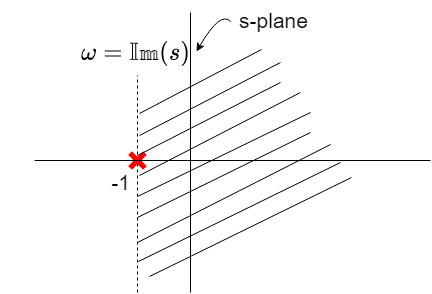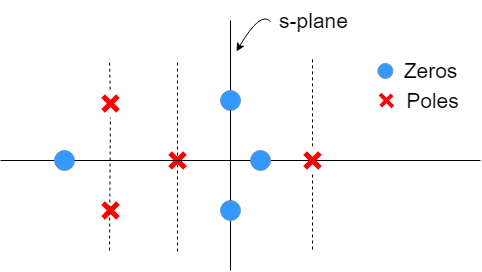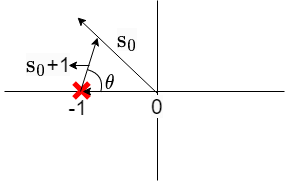The Laplace transform of a continuous time signal x(t) can be expressed as:
X(s)=∫−∞∞x(t)e−stdt
Where s=σ+jω represent a complex frequency on a complex number plane.
e−st=e−(σ+jω)t=e−σte−jωt
We can clearly see that
Re{e−st}=e−σtcos(ωt)
Im{e−st}=−e−σtsin(ωt)
Eigenfunctions of LTI systems
Let the system h(t) be a linear and time invariant (LTI) system and the input x(t)=est. The output y(t) of this system can be written as

y(t)=est∗h(t)
=∫−∞∞h(τ)es(t−τ)dτ
=∫−∞∞ h(τ) est e−sτ dτ
=est∫−∞∞ h(τ) e−sτdτ
=H(s)est
est is known as eigen function for LTI system and it preserved the shape of the input signal.
Note:
All RLC circuits are LTI systems
Any AC source always gives sinusoidal voltage/current across any part of the circuit
The amplitude and phase might change but the shape remains the same
The Laplace transform has always two parts:
Mathematical expression
Region of convergence: the region in s-plane, where the mathematical expression is valid.
Example:
x(t)=e−tu(t)
Solution: We know that Laplace tranform is given as:
X(s)=∫−∞ inftyx(t)e−stdt
=∫0∞e−te−stdt
=∫0 infitye−(s+1)tdt
=s+11
Region of convergence (ROC) is region in the s-plane where the above expression is valid.
The expression is valid if Re{s+1}>0 i.e. Re{s}>−1. s=−1 is a point of singularity.

Let X(s) be the polynomials in s variable as below:
X(s)=B(s)A(s)
Roots of A(s) i.e. A(s)=0→ zeros
Roots of B(s) i.e. A(s)=0→ poles
Note: Poles play important role to decide ROC nit ROC cannot have poles within them.
Exercise:
What is the ROC in above example?

Linear constant coefficient differential equations (LCCDE):
Any linear constant coefficient differential equations (LCCDE) in Laplace domain can be expressed as ratio of polynomials.
Example: Let x(t)=dtdy+a y(t)
Taking Laplace transform of the above equation:
X(s)=sY(s)+aY(s)
X(s)=(s+a) Y(s)
Y(s)=s+aX(s)
H(s)=X(s)Y(s)=s+a1
Here H(s) is known as transfer function or system function.

Let h(t) be the system with input x(t) and output being y(t).
y(t)=x(t)∗h(t)
The system input-output relationship in Laplace transform can be expressed as:
Y(s)=X(s)H(s)
We are interested in additional system properties and their effect on impulse response and system function
Causality of LTI system:
For LTI system to be causal, we should have
h(t)=0, ∀ t<0
y(t)=x(t)∗h(t)=∫−∞∞x(τ)h(t−τ)dτ
For Causality: we should only use x(τ) for τ≤t
τ>t, h(t−τ)=0
h(t)=0 ∀ t<0
For a causal system (h(t) is a right-sided signal) , what is nature of H(s) ?
ROC of H(s) will be right-sided plane. (Converse is not true in general)
For a system with rational system function, causality is equivalent to the ROC being right-sided plane to the right of right most pole.
Example:
- H(s)=s+11 and Re{s}>−1
h(t)=e−tu(t) (Causal)
- H(s)=s+1es and Re{s}>−1
h(t)=e−(t+1)u(t+1) (Non-causal)
An LTI system is said to be stable if
∫∞∞∣h(t)∣dt<∞
i.e. h(t) is absolutely integrable
We know Laplace transform is given as:
H(s)=∫∞∞h(t)e−stdt
H(s)∣s=0=∫∞∞h(t)dt<∞
Laplace transform converges at s=0, In fact, for any s=jω=0+jω, H(s)∣s=jω<∞→ system is stable
Note: jω-axis i.e. Re{s}=0 is part of the ROC
Example:
- Shifting operator: h(t)=δ(t−t0)Taking Laplace transform: H(s)=est0 ROC: Full s-plane (stable)
- Integrator: h(t)=u(t)
Taking Laplace transform: H(s)=s1 ROC: Re{s}>0 (Not stable)
Note: A causal system with rational system function is stable if and only if: all the poles have negative real part
Frequency analysis and geometric interpretation:
Let H(s)=s+11
The pole-zero plot on s-plane is

Evaluating H(s) at any point at s=s0 in the s-plane
H(s)∣s=s0=s0+11

H(s)∣s=s0=∣H(s0)∣ej∠H(s0)
∣H(s0)∣=∣s0+1∣1 and ∠H(s0)=θ
Given a rational system function:
H(s)=∏i=1N(s−pi)∏i=1M(s−zi)and ROC N>M
∣H(s)∣s=s0=∏i=1N∣s0−Pi∣∏i=1M(s−zi)
∠H(s)∣s=s0=∑i=1M∠(s0–zi)−∑i=1N∠(s0–Pi)
Example:
Let x(t)=cos(ω0t) for given H(s)=s+11 and Re{s}>−1
cos(ω0t)→1+ω021cos(ωot−θ)
where θ=tan−1(ω0)
∣H(jωo)∣=1+ω021→ Low pass filter
For any LTI system cos(ωo)→∣H(jωo)∣cos(ωot−θ)
and θ=∠ H(jω0)
where ∣H(jωo)∣→magnitude response and ∠H(jωo)→phase response
The H(s)=s+1s→ High Pass filter






